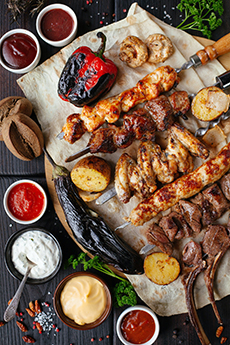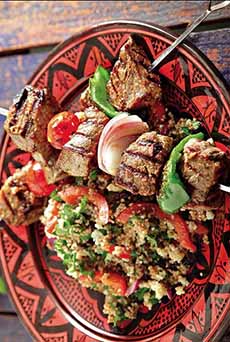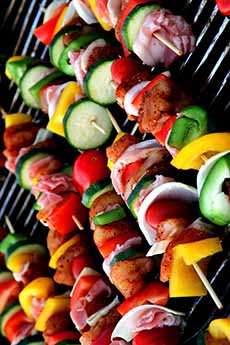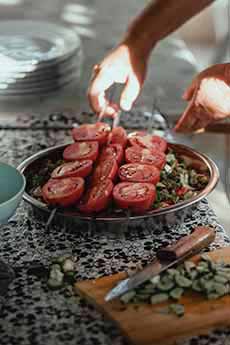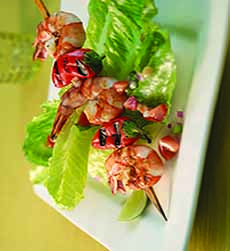TIP OF THE DAY: Mediterranean Food For Labor Day & A Mezze Buffet
|
Labor Day pays tribute to the contributions and achievements of American workers*, and an all-American cookout is traditionally on the menu? But what if you decided instead to observe the cuisine of laborers elsewhere? Most of us have a Labor Day grilling routine. We decided to try a different grilling menu, focusing on a sure-to-delight theme: skewers. The word kebab† refers to fish, meat or vegetables that are roasted or grilled on a skewer or spit. In the U.S., “skewers” has become the term used outside of Mediterranean restaurants. This Labor Day we’re going kebab crazy, with grilled skewers and Greek and Middle Eastern sides, the latter called mezze in Greek. Scroll down to see all the mezze. The hardest part for us is deciding what to make (or buy). We want them all! Instead of an American buffet with grilled whole foods like brats, burgers, chicken, fish, franks or steaks, we’re grilling skewers of some of the same meats: We decided to bypass the corn on the cob and potato salad for Mediterranean sides, like Israeli salad and basmati rice pilaf with dried fruits and almonds. We’ve also chosen three Mediterranean spreads, to enjoy on their own or dip with pita triangles. Because hummus, baba ganoush and tabbouleh are everyday foods at our house, we chose three other: tzatziki/cacik seasoned yogurt, which is a great side to the grilled meats; skordalia, garlicky potato purée; and melitzanosalata, a chunky eggplant dip. Mediterranean Dips/Spreads In Greek these are called mezze (MEH-zay), meze in Arabic. They are a selection of small dishes that originally accompanied drinks, either as a snack or as a first course to a meal. Mezze can include the dips and spreads on this list, served with pita; plus dolmades (stuffed grape leaves), falafel, feta, halloumi cheese, kibbeh, olives and other Mediterranean delights. Check out this list for a “full menu.” Depending on country—Greece versus any of the countries in what was formerly called the Levant*—there may be different names for the same or similar dishes. For example, Greek tzatziki is Turkish cacik. Here are a dozen favorites. Note that spellings may differ because the names are transliterated into the Latin alphabet from the Arabic or Greek alphabets. Babaganoush: Smoky roasted eggplant and tahini combine in a dip that can be smooth or chunky. Baba ghannouj is another spelling. Here’s a recipe. Cacik: The Turkish name for tzatiki, a yogurt and cucumber dip. It is pronounced kah-SEEK. Ezme: Similar to Israeli salad, ezme is a Turkish salad of finely chopped tomatoes, cucumbers, onions, mild peppers, parsley and olive oil. Hummus: A paste of chickpeas, olive oil, garlic and spices. There surge in popularity has resulted in dozens of blend-ins, from the traditional Mediterranean flavors (olive, red pepper) to the trendy (chipotle, edamame hummus, everything bagel topping). Here’s a recipe to make your own. Labneh: Labneh is thick, strained yogurt with a consistency similar to spreadable cheese like cream cheese. It is spread onto pita. Here’s more about it, and a recipe. Htipiti: Htipiti (tee-PEE-tee) is a spicy spread of roasted red pepper and feta, mixed with olive oil, thyme, shallots and garlic. It can be smooth or chunky, and is closely related to kopanisti and tirokafteri (see below). Melitzanosalata: This traditional Greek Eggplant dip is difference from baba ghanoush in that the latter is Levantine‡ and uses tahini. Melitzanosalata is Greek and doesn’t have tahini. Common ingredients are eggplant, olive oil, garlic, lemon, salt, pepper. Some melitzanosalata recipes add onion. Chopped parsley is a traditional garnish. Muhammara: A Syrian dish of roasted red peppers, walnuts and pomegranate molasses. Skordalia: A Greek potato and garlic dip (purée). Tabbouleh: A salad of bulgur, chopped parsley, mint, onion and tomatoes, seasoned with olive oil, lemon juice, salt and pepper. Taramasalata: A spread made from tarama, cured carp (or other fish) roe, whipped with lemon juice and olive oil. Tirokafteri: Feta cheese dip, similar to htipiti. It includes feta, olive oil, red wine vinegar, chopped chilies or red pepper flakes, oregano, and often roasted red peppers (not hot) and yogurt. Kopanisti, another spicy feta dip, includes olive oil, lemon juice, mint, pepperoncini, garlic and red pepper flakes. Tzatziki: A yogurt and cucumber dip. It is very similar to Indian raita, and like the latter, it is also served with grilled meats. Here are recipes for both. |
|
|
|
KEBAB HISTORY Spell it kebap, kabab, It appears in Turkish texts as early as the 14th century, meaning roasted meat. It may be broiled or grilled on skewers, but also the word also refers to meatballs, stews and other formats. In English, the word has come to mean food on a skewer, be it small chunks of meat, seafood, vegetables, seitan, tofu, etc. The word kebab likely came to English in the late 17th century from the Arabic kabāb, which has roots in the Persian, Turkish, Urdu and other old tongues, including Aramaic and its predecessor, Akkadian. The skewered form has spread around the world, from Europe and the U.S. to the satays of Southeast Asia. ________________ *Labor Day is observed on the first Monday in September. It was created by the labor movement in the late 19th century and became a federal holiday in 1894. Here’s more about it. †The word kebab came to the English language in the late 17th century, from the Arabic word kabāb. Kabāb, in turn, derived from kabab, from the Persian, Turkish and Urdu languages. Transliterated from the Arabic alphabet, there are various spellings including kabob and kebap. ‡The Levant was a large area in southwest Asia: south of the Taurus Mountains, with the Mediterranean Sea as the western boundary, and the north Arabian Desert and Mesopotamia in the east. “Levant” is an English term that first appeared in 1497. It originally referred to the “Mediterranean lands east of Italy.” The historical area comprises modern-day Iraq, Israel, Jordan, Lebanon, Palestine and Syria. Among other popular foods, Levantine cuisine gave birth to baklava, falafel, kebabs, mezze (including tabbouleh, hummus and baba ghanoush), pita and za’atar, among other dishes that are enjoyed in the U.S. and around the world.
|
||
